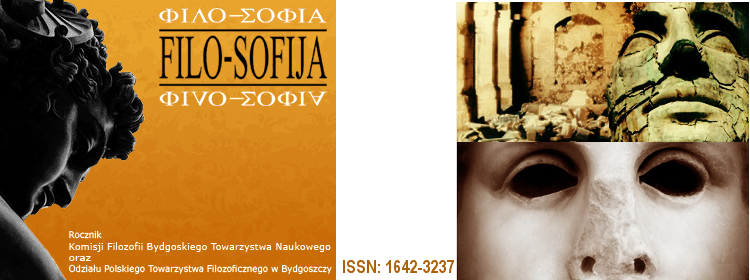Artysta versus Robotnik. Interpretacja losu czŇāowieka nowoczesnego na podstawie linorytu Jacka SoliŇĄskiego i jego egzegezy autorstwa Marka Kazimierza Siwca
Abstract
This article is a kind of glossary on Jacek Solinski‚Äôs linocut Byńá teraz [English: To BeNow] and his interpretation by Marek Kazimierz Siwiec pt. Teraz, czyli kropla czystego ŇõwiatŇāa. Linoryt Jacka SoliŇĄskiego ‚ÄěByńá teraz‚ÄĚ ‚Äď punkt widzenia tw√≥rcy i dramat egzystowania [English: Now, i.e. a Drop of Pure Light. Jacek Solinski‚Äôs Linocut ¬ĽToBe Now¬ę ‚Äď Creative‚Äôs Point of View and Drama of Existence].
In the first part, after a brief presentation of the main points of Siwiec’s exegesis, the article provides a polemical commentary that extracts some, in the author’s opinion, inconsistencies or errors appearing in the text in question. It does not reject them, butpoints to their hidden motive. They come from Siwiec’s suggestion that the source oflight, which beats from the center of the spider’s web, is a proper source. The second part of the article presents an alternative interpretation. There is two sources of light: first one shines in center of web, but it is only reflex which glasses second and propersource of light. It hides outside the frame, behind the back of a man sitting on the beam. This interpretation causes that the poles, between which plays out the drama of sittingman, turn into places: what in Siwiec’s interpretation was the proper aim of the artist’s aspiration and vision becomes an idol, whereas what Siwiec did not pay attention to, and what is hidden behind the back of the sitting man and the frame, is a proper source (star). Speaking with the language J.L. Marion, it would be possible to define this true source of light as “distance.
‚ÄĚReferring to the title ‚Äúto be now‚ÄĚ, the article distinguishes three meanings of present. First of all, it is ‚Äúnow‚ÄĚ of sitting man. We understand the moment as the absolute present, which does not know the extent of time. Secondly, it is the ‚Äúnow‚ÄĚ of viewer who puts this ‚Äúnow‚ÄĚ in the perspective of the past and the future. Third, it is an anonymous ‚Äúnow,‚ÄĚ identical to eternity.
The next question is, who is the man sitting on the beam. The article proposes the figure of J√ľnger‚Äôs Worker, which embraces both the artist and the worker: it is a modern way of being of man who defines work and whose horizon of life is a technology.
At the end of the discussion, the article addresses questions that go beyond Siwiec‚Äôs interpretation and SoliŇĄski‚Äôs linocut, and go towards the truth of the being: Is there any alternative of ‚Äúbeing now,‚ÄĚ besides ‚Äúbeing now,‚ÄĚ understood either as an instant decision, or as a waiting for a decision which makes outside the subject?
In the first part, after a brief presentation of the main points of Siwiec’s exegesis, the article provides a polemical commentary that extracts some, in the author’s opinion, inconsistencies or errors appearing in the text in question. It does not reject them, butpoints to their hidden motive. They come from Siwiec’s suggestion that the source oflight, which beats from the center of the spider’s web, is a proper source. The second part of the article presents an alternative interpretation. There is two sources of light: first one shines in center of web, but it is only reflex which glasses second and propersource of light. It hides outside the frame, behind the back of a man sitting on the beam. This interpretation causes that the poles, between which plays out the drama of sittingman, turn into places: what in Siwiec’s interpretation was the proper aim of the artist’s aspiration and vision becomes an idol, whereas what Siwiec did not pay attention to, and what is hidden behind the back of the sitting man and the frame, is a proper source (star). Speaking with the language J.L. Marion, it would be possible to define this true source of light as “distance.
‚ÄĚReferring to the title ‚Äúto be now‚ÄĚ, the article distinguishes three meanings of present. First of all, it is ‚Äúnow‚ÄĚ of sitting man. We understand the moment as the absolute present, which does not know the extent of time. Secondly, it is the ‚Äúnow‚ÄĚ of viewer who puts this ‚Äúnow‚ÄĚ in the perspective of the past and the future. Third, it is an anonymous ‚Äúnow,‚ÄĚ identical to eternity.
The next question is, who is the man sitting on the beam. The article proposes the figure of J√ľnger‚Äôs Worker, which embraces both the artist and the worker: it is a modern way of being of man who defines work and whose horizon of life is a technology.
At the end of the discussion, the article addresses questions that go beyond Siwiec‚Äôs interpretation and SoliŇĄski‚Äôs linocut, and go towards the truth of the being: Is there any alternative of ‚Äúbeing now,‚ÄĚ besides ‚Äúbeing now,‚ÄĚ understood either as an instant decision, or as a waiting for a decision which makes outside the subject?
PeŇāny tekst:
PDFAdministracja Cytowania | Strony czasopism
